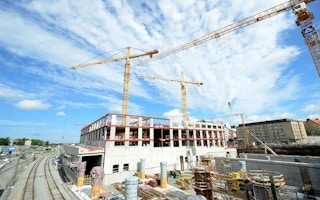While the California construction industry was severely impacted by the 2008 financial crisis, there is no doubt that it is now on an upward swing now. But one other major phenomenon is threatening its success: the extreme droughts that have plagued the state for four years now – what some people are calling the worst droughts in 1200 years.
To continue reading, subscribe to Eco‑Business.
There's something for everyone. We offer a range of subscription plans.
- Access our stories and receive our Insights Weekly newsletter with the free EB Member plan.
- Unlock unlimited access to our content and archive with EB Circle.
- Publish your content with EB Premium.
Since Governor Jerry Brown instituted mandatory cutbacks in water use, many industries have come under increased scrutiny, and the construction industry is no exception. But is the news all bad for the industry? Let’s take a closer look.
The hardest-hit businesses
Understandably, and unfortunately for many contractors, one of the businesses most severely hit by the new regulations is pool construction. Pool construction has been enjoying a great resurgence. Last year alone, 11,000 new pools were constructed or rebuilt, comparable with pre-recession numbers. This year, demand is expected to go even higher, but statewide regulations might put a stop to it. Some districts and municipalities have gone so far as to ban new pool construction altogether.
Naturally, pool contractors aren’t happy about this. Some industry groups are trying to persuade those districts and municipalities that pool construction, in fact, saves water in the long run, especially compared with popular types of landscaping such as grass and turf. They even argue that the use of pool covers can make pools as water efficient as California Friendly plants.
Landscaping, of course, is also facing a major impact from the new rule. Landscaped areas of 500 feet or larger, whether they are newly built or being renovated, will have to restrict turf areas to 25 per cent of the entire landscaped area. This rule applies to the entire project a builder is working on, rather than just an individual lot.
Can these regulations be positive?
While complying with stringent regulations is never an easy thing, even this cloud has a silver lining.
For starters, home building won’t be affected, because state regulators understand that it has always been a driver in the economy. It’s not only economical, but ecological: new homes are generally far more water-efficient than old ones. In fact, according to a report by the California Building Industry Association, new homes use up to 50 per cent less water than homes built before the 1980s, and 20 per cent less water than those built in the 1990s.
At the same time, many cities are starting to impose different limitations on their water supplies. Some households currently pay flat rates regardless of their water usage, which will certainly change as the drought aggravates, especially considering that 57 per cent of all household use is attributed to landscaping.
What this means for the industry is that there will be a lot of work for remodeling and landscaping contractors, as well as for engineers and plumbers, as people start installing new, more water-efficient appliances, low-flush toilets, low-flow faucets, artificial turf, drought-resistance plants and new irrigation systems. It’s likely that many of these will actually be required by code in the future.
Another way contractors can benefit from the tight water rules is through offering water neutral pools. These are already available in Australia, but word is spreading in the US. Water neutral pools do not use water from a building’s main water supply, but from rainwater collecting systems. These rainwater tanks claim to be so efficient that there is usually some water left for other purposes, such as watering the lawn – meaning that homeowners don’t have to choose between one or the other.
Finally, well drilling is also likely to increase, so contractors licensed to drill wells will see some new business too. Now may be a good time to review contractor license bond requirements.
Taking a closer look at some of the issues and new guidelines, it looks like, despite the apparent difficulties presented by California’s drought, the construction industry will be able to continue its growth by adapting to the new demands for solutions that conserve more energy and water. Ultimately, the drought is an ideal opportunity to make our homes and our businesses more efficient.
Lachezar Stamatov has extensive experience blogging about all surety bond-related topics with a focus on small business and the construction industry.










